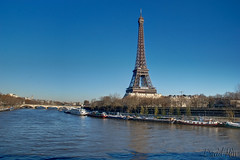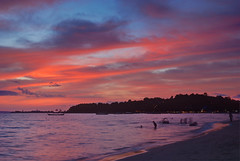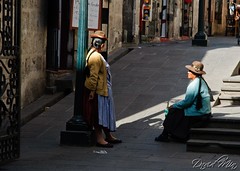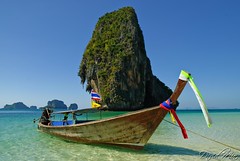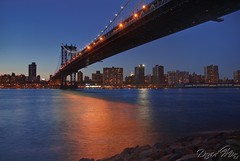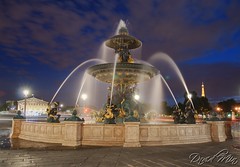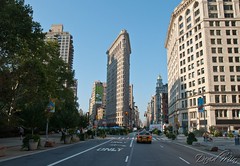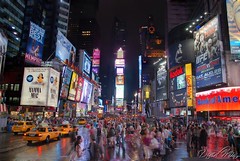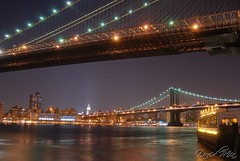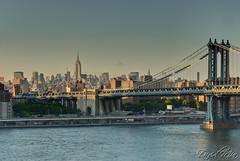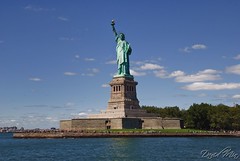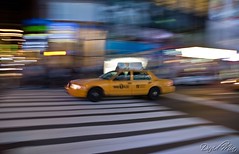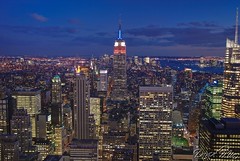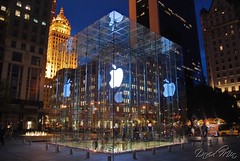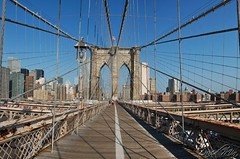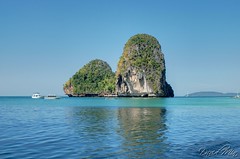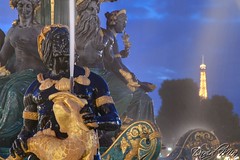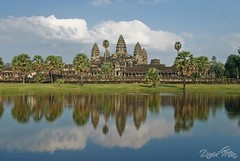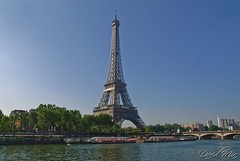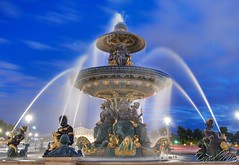The Eiffel Tower is an 1889 iron lattice tower located on the Champ de Mars in Paris that has become both a global icon of France and one of the most recognizable structures in the world. The Eiffel Tower, which is the tallest building in Paris, is the single most visited paid monument in the world; millions of people ascend it every year. Named after its designer, engineer Gustave Eiffel, the tower was built as the entrance arch for the 1889 World's Fair.
The tower stands 324 m tall, about the same height as an 81-storey building. It was the tallest man-made structure in the world from its completion until the Chrysler Building in New York City was built in 1930.The tower has three levels for visitors. Tickets can be purchased to ascend by stairs or lift to the first and second levels. The walk to the first level is over 300 steps, as is the walk from the first to the second level. The third and highest level is accessible only by lift. Both the first and second levels feature restaurants.
The tower has become the most prominent symbol of both Paris and France, often in the establishing shot of films set in the city.
Thursday, December 16, 2010
Sunday, December 12, 2010
Basilica of the Sacred Heart of Jesus of Paris under the snow
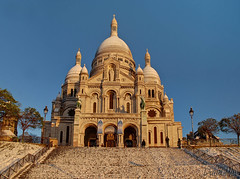
Basilica of the Sacred Heart of Jesus of Paris under the snow
Originally uploaded by GlobeTrotter 2000
Saturday, December 11, 2010
Singapore, Clarke Quay
Clarke Quay is a historical riverside quay in Singapore, located within the Singapore River Planning Area. The quay is situated upstream from the mouth of the Singapore River and Boat Quay.
The Singapore River has been the centre of trade since modern Singapore was founded in 1819. During the colonial era, Boat Quay was the commercial centre where barge lighters would transport goods upstream to warehouses at Clarke Quay.
At the height of its prosperity, dozens of bumboats jostled for mooring space beside Clarke Quay. This continued well into the latter half of the twentieth century. By this time, the Singapore River had also become very polluted. The government decided to relocate cargo services to a new modern facility in Pasir Panjang. The bumboats and lorries departed to their new home and Clarke Quay fell silent.
The Singapore River has been the centre of trade since modern Singapore was founded in 1819. During the colonial era, Boat Quay was the commercial centre where barge lighters would transport goods upstream to warehouses at Clarke Quay.
At the height of its prosperity, dozens of bumboats jostled for mooring space beside Clarke Quay. This continued well into the latter half of the twentieth century. By this time, the Singapore River had also become very polluted. The government decided to relocate cargo services to a new modern facility in Pasir Panjang. The bumboats and lorries departed to their new home and Clarke Quay fell silent.
Sunday, December 5, 2010
NYC - Empire State Building
The Empire State Building is a 102-story landmark Art Deco skyscraper in New York City at the intersection of Fifth Avenue and West 34th Street. Its name is derived from the nickname for New York, The Empire State. It stood as the world's tallest building for more than 40 years, from its completion in 1931 until construction of the World Trade Center's North Tower was completed in 1972. Following the destruction of the World Trade Center in 2001, the Empire State Building again became the tallest building in New York City.
Saturday, December 4, 2010
Sihanouville, Cambodia - Sunset @Occheuteal Beach
It may be difficult to pronounce, but the name certainly hasn't put people off the longest and most popular beach in Sihanoukville, though many know it now as the far easier to pronounce Serendipity Beach.
Much of it is dedicated to food stalls and small bamboo bars, but the southern stretch is largely deserted, save for a development project, including a golf course, which has seemingly been under construction forever.
Popular with barangs and Khmers alike, the weekends are particularly busy with snacking Phnom Penh escapees mingling with backpackers and day-trippers from other beaches.
Much of it is dedicated to food stalls and small bamboo bars, but the southern stretch is largely deserted, save for a development project, including a golf course, which has seemingly been under construction forever.
Popular with barangs and Khmers alike, the weekends are particularly busy with snacking Phnom Penh escapees mingling with backpackers and day-trippers from other beaches.
Sunday, November 28, 2010
New York city - Central Park
Central Park is one of those places that make New York such a great place to live. The huge park, 843 acres large (341 ha), is located in the center of Manhattan. Its design is an example for city parks around the world.
The park boasts several lakes, theaters, ice rinks, fountains, tennis courts, baseball fields, many playgrounds and other facilities. It is also home to the Central Park Zoo and the Metropolitan Museum of Art. Especially during the weekends, when cars are not allowed into the park, Central Park is a welcome oasis in this hectic city.
The park boasts several lakes, theaters, ice rinks, fountains, tennis courts, baseball fields, many playgrounds and other facilities. It is also home to the Central Park Zoo and the Metropolitan Museum of Art. Especially during the weekends, when cars are not allowed into the park, Central Park is a welcome oasis in this hectic city.
Sunday, November 14, 2010
Sydney Opera House, Australia
The Sydney Opera House is a multi-venue performing arts centre in Sydney, New South Wales, Australia. It was conceived and largely built by Danish architect Jørn Utzon, who, in 2003, received the Pritzker Prize, architecture's highest honour.
The Sydney Opera House was made a UNESCO World Heritage Site on 28 June 2007. It is one of the 20th century's most distinctive buildings and one of the most famous performing arts centres in the world.
The Sydney Opera House is situated on Bennelong Point in Sydney Harbour, close to the Sydney Harbour Bridge. It sits at the northeastern tip of the Sydney central business district (the CBD), surrounded on three sides by the harbour (Sydney Cove and Farm Cove) and neighboured by the Royal Botanic Gardens.
Contrary to its name, the building houses multiple performance venues. As one of the busiest performing arts centres in the world, hosting over 1,500 performances each year attended by some 1.2 million people, the Sydney Opera House provides a venue for many performing arts companies including the four key resident companies Opera Australia, The Australian Ballet, the Sydney Theatre Company and the Sydney Symphony Orchestra, and presents a wide range of productions on its own account. It is also one of the most popular visitor attractions in Australia, with more than seven million people visiting the site each year, 300,000 of whom take a guided tour.
The Sydney Opera House was made a UNESCO World Heritage Site on 28 June 2007. It is one of the 20th century's most distinctive buildings and one of the most famous performing arts centres in the world.
The Sydney Opera House is situated on Bennelong Point in Sydney Harbour, close to the Sydney Harbour Bridge. It sits at the northeastern tip of the Sydney central business district (the CBD), surrounded on three sides by the harbour (Sydney Cove and Farm Cove) and neighboured by the Royal Botanic Gardens.
Contrary to its name, the building houses multiple performance venues. As one of the busiest performing arts centres in the world, hosting over 1,500 performances each year attended by some 1.2 million people, the Sydney Opera House provides a venue for many performing arts companies including the four key resident companies Opera Australia, The Australian Ballet, the Sydney Theatre Company and the Sydney Symphony Orchestra, and presents a wide range of productions on its own account. It is also one of the most popular visitor attractions in Australia, with more than seven million people visiting the site each year, 300,000 of whom take a guided tour.
Saturday, November 13, 2010
Sydney Opera House @sunset, Australia
The Sydney Opera House is a multi-venue performing arts centre in Sydney, New South Wales, Australia. It was conceived and largely built by Danish architect Jørn Utzon, who, in 2003, received the Pritzker Prize, architecture's highest honour.
The Sydney Opera House was made a UNESCO World Heritage Site on 28 June 2007. It is one of the 20th century's most distinctive buildings and one of the most famous performing arts centres in the world.
The Sydney Opera House is situated on Bennelong Point in Sydney Harbour, close to the Sydney Harbour Bridge. It sits at the northeastern tip of the Sydney central business district (the CBD), surrounded on three sides by the harbour (Sydney Cove and Farm Cove) and neighboured by the Royal Botanic Gardens.
Contrary to its name, the building houses multiple performance venues. As one of the busiest performing arts centres in the world, hosting over 1,500 performances each year attended by some 1.2 million people, the Sydney Opera House provides a venue for many performing arts companies including the four key resident companies Opera Australia, The Australian Ballet, the Sydney Theatre Company and the Sydney Symphony Orchestra, and presents a wide range of productions on its own account. It is also one of the most popular visitor attractions in Australia, with more than seven million people visiting the site each year, 300,000 of whom take a guided tour.
The Sydney Opera House was made a UNESCO World Heritage Site on 28 June 2007. It is one of the 20th century's most distinctive buildings and one of the most famous performing arts centres in the world.
The Sydney Opera House is situated on Bennelong Point in Sydney Harbour, close to the Sydney Harbour Bridge. It sits at the northeastern tip of the Sydney central business district (the CBD), surrounded on three sides by the harbour (Sydney Cove and Farm Cove) and neighboured by the Royal Botanic Gardens.
Contrary to its name, the building houses multiple performance venues. As one of the busiest performing arts centres in the world, hosting over 1,500 performances each year attended by some 1.2 million people, the Sydney Opera House provides a venue for many performing arts companies including the four key resident companies Opera Australia, The Australian Ballet, the Sydney Theatre Company and the Sydney Symphony Orchestra, and presents a wide range of productions on its own account. It is also one of the most popular visitor attractions in Australia, with more than seven million people visiting the site each year, 300,000 of whom take a guided tour.
Saturday, October 30, 2010
New York City - Top Of The Rock Vertorama
Top Of The Rock is an experience in history and scenery that culminates with unparalleled views of New York City from the newly reopened Observation Deck on the 70th floor of 30 Rockefeller Center, in the heart of midtown Manhattan.
There's a certain peace at 70 stories above the city, and Top Of The Rock Observation Deck is conceived with the express purpose of keeping that peace uninterrupted. Panels of fully transparent safety glass - the only thing between visitors and the city - are crystal clear for unobstructed, open-air viewing.
The view itself is unique and astonishing. Unobstructed for 360 degrees from the 70th floor, the breathtaking landscape stretches for miles in every direction. It includes a panorama of Central Park and the northern half of Manhattan that cannot be found anywhere else. New York's other landmarks are visible as well, including the Chrysler Building, Times Square, the Hudson River, the East River, the Brooklyn Bridge, and the Statue of Liberty. It is, quite simply, the most spectacular view in New York City.
There's a certain peace at 70 stories above the city, and Top Of The Rock Observation Deck is conceived with the express purpose of keeping that peace uninterrupted. Panels of fully transparent safety glass - the only thing between visitors and the city - are crystal clear for unobstructed, open-air viewing.
The view itself is unique and astonishing. Unobstructed for 360 degrees from the 70th floor, the breathtaking landscape stretches for miles in every direction. It includes a panorama of Central Park and the northern half of Manhattan that cannot be found anywhere else. New York's other landmarks are visible as well, including the Chrysler Building, Times Square, the Hudson River, the East River, the Brooklyn Bridge, and the Statue of Liberty. It is, quite simply, the most spectacular view in New York City.
Saturday, October 16, 2010
NYC - Empire State Building
The Empire State Building is a 102-story landmark Art Deco skyscraper in New York City at the intersection of Fifth Avenue and West 34th Street. Its name is derived from the nickname for New York, The Empire State. It stood as the world's tallest building for more than 40 years, from its completion in 1931 until construction of the World Trade Center's North Tower was completed in 1972. Following the terrorist bombing and destruction of the World Trade Center in 2001, the Empire State Building again became the tallest building in New York City.
The Empire State Building has been named by the American Society of Civil Engineers as one of the Seven Wonders of the Modern World.
The Empire State Building has been named by the American Society of Civil Engineers as one of the Seven Wonders of the Modern World.
Friday, October 15, 2010
Streets of Arequipa, Peru
Arequipa is the capital city of the Arequipa Region in southern Peru. With a population of 904,931 it is the second most populous city of the country. Arequipa lies in the Andes mountains, at an altitude of 2,380 meters above sea level; the snow-capped volcano El Misti overlooks the city.
The city has many colonial-era Spanish buildings built of sillar, a pearly white volcanic rock, from which it gets the nickname La Ciudad Blanca ("The White City"). Reportedly, it first acquired this nickname in the colonial era, because most of its inhabitants were Creole of Iberian descent. The historic centre of Arequipa was named a UNESCO World Heritage Site in 2000, in recognition of its architecture and historic integrity.
People who visit this city can admire the colonial architecture in the historical center of Arequipa, the magnificent Inca terraces in the countryside surrounding districts, and a very extensive landscape, product of human and nature creation, an important factor in its declaration as Cultural Heritage Humanity.
The city has many colonial-era Spanish buildings built of sillar, a pearly white volcanic rock, from which it gets the nickname La Ciudad Blanca ("The White City"). Reportedly, it first acquired this nickname in the colonial era, because most of its inhabitants were Creole of Iberian descent. The historic centre of Arequipa was named a UNESCO World Heritage Site in 2000, in recognition of its architecture and historic integrity.
People who visit this city can admire the colonial architecture in the historical center of Arequipa, the magnificent Inca terraces in the countryside surrounding districts, and a very extensive landscape, product of human and nature creation, an important factor in its declaration as Cultural Heritage Humanity.
Tuesday, October 5, 2010
Railay Beach - Thailand
place you just need to visit is Railey/Railay beach in Thailand. Railey is one of Thailand's most sought after beach areas. Just south of Ao Nang Beach, around a rocky headland and accessible only by boat, Railay presents a private and extraordinary world.
In just one small peninsula you'll find gorgeous white sand beaches, soaring limestone cliffs, viewpoints, caves and hidden lagoons inside the cliffs, shaped and fed by the changing tides. All within walking distance !
At Railay there are no roads, only footpaths. No buses, no cars, just local "longtail" boats. Although it's actually connected to the mainland, the spectacular Phra Nang peninsular is effectively isolated by limestone headlands and steep jungle valleys from Krabi's main holiday areas. The very picture of tropical paradise, with no roads and no hassle, Railay offers lazy days, adventure forays and chilled-out evenings.
In just one small peninsula you'll find gorgeous white sand beaches, soaring limestone cliffs, viewpoints, caves and hidden lagoons inside the cliffs, shaped and fed by the changing tides. All within walking distance !
At Railay there are no roads, only footpaths. No buses, no cars, just local "longtail" boats. Although it's actually connected to the mainland, the spectacular Phra Nang peninsular is effectively isolated by limestone headlands and steep jungle valleys from Krabi's main holiday areas. The very picture of tropical paradise, with no roads and no hassle, Railay offers lazy days, adventure forays and chilled-out evenings.
Saturday, October 2, 2010
NYC - Manhattan Bridge
The Manhattan Bridge is a suspension bridge that crosses the East River in New York City, connecting Lower Manhattan (at Canal Street) with Brooklyn (at Flatbush Avenue Extension). It was the last of the three suspension bridges built across the lower East River, following the Brooklyn and the Williamsburg bridges.
It has four vehicle lanes on the upper level (split between two roadways). The lower level has three lanes, four subway tracks, a walkway and a bikeway. The upper level, originally used for streetcars, has two lanes in each direction, and the lower level is one-way and has three lanes in peak direction.
The original pedestrian walkway on the south side of the bridge was reopened after forty years in June 2001. It was also used by bicycles until late summer 2004, when a dedicated bicycle path was opened on the north side of the bridge, and again in 2007 while the bike lane was used for truck access during repairs to the lower motor roadway.
The neighborhood near the bridge on the Brooklyn side, once known as Fulton Landing has been gentrified and is called DUMBO, an acronym for Down Under the Manhattan Bridge Overpass.
It has four vehicle lanes on the upper level (split between two roadways). The lower level has three lanes, four subway tracks, a walkway and a bikeway. The upper level, originally used for streetcars, has two lanes in each direction, and the lower level is one-way and has three lanes in peak direction.
The original pedestrian walkway on the south side of the bridge was reopened after forty years in June 2001. It was also used by bicycles until late summer 2004, when a dedicated bicycle path was opened on the north side of the bridge, and again in 2007 while the bike lane was used for truck access during repairs to the lower motor roadway.
The neighborhood near the bridge on the Brooklyn side, once known as Fulton Landing has been gentrified and is called DUMBO, an acronym for Down Under the Manhattan Bridge Overpass.
Sunday, September 26, 2010
Paris, France - Fountains on the Place de la Concorde
The city of Paris has some of the world's most beautiful fountains. One of the prettiest fountains can be found near the Obelisque at the Place de la Concorde.
The two fountains in the Place de la Concorde have been the most famous of the fountains built during the time of Louis-Philippe, and came to symbolize the fountains in Paris. They were designed by Jacques-Ignace Hittorff, a student of the Neoclassical designer Charles Percier at the Ecole des Beaux-Arts. The German-born Hittorff had served as the official Architect of Festivals and Ceremonies for the deposed King, and had spent two years studying the architecture and fountains of Italy.
Hittorff's two fountains were on the theme of rivers and seas, in part because of their proximity to the Ministry of Navy on the Place de la Concorde, and to the Seine. Their arrangement, on a north-south axis aligned with the obelisk of Luxor, and the Rue Royale, and the form of the fountains themselves, were influenced by the fountains of Rome, particularly Piazza Navona and the Piazza San Pietro, both of which had obelisks aligned with fountains.
The two fountains in the Place de la Concorde have been the most famous of the fountains built during the time of Louis-Philippe, and came to symbolize the fountains in Paris. They were designed by Jacques-Ignace Hittorff, a student of the Neoclassical designer Charles Percier at the Ecole des Beaux-Arts. The German-born Hittorff had served as the official Architect of Festivals and Ceremonies for the deposed King, and had spent two years studying the architecture and fountains of Italy.
Hittorff's two fountains were on the theme of rivers and seas, in part because of their proximity to the Ministry of Navy on the Place de la Concorde, and to the Seine. Their arrangement, on a north-south axis aligned with the obelisk of Luxor, and the Rue Royale, and the form of the fountains themselves, were influenced by the fountains of Rome, particularly Piazza Navona and the Piazza San Pietro, both of which had obelisks aligned with fountains.
Thursday, September 23, 2010
NYC - Only, Only ... Flatiron Building
The Flatiron Building, or Fuller Building as it was originally called, is located at 175 Fifth Avenue in the borough of Manhattan, and is considered to be one of the first skyscrapers ever built. Upon completion in 1902 it was one of the tallest buildings in New York City. The building sits on a triangular island block at 23rd Street, Fifth Avenue, and Broadway, anchoring the south (downtown) end of Madison Square.
The neighborhood around the building is called the Flatiron District after its signature building, which has become an icon of New York.
Today, the Flatiron Building is frequently seen on television commercials and documentaries as an easily recognizable symbol of the city, shown, for instance, in the opening credits of The Late Show With David Letterman or in scenes of New York City that are shown during scene transitions in the show "Friends".
The neighborhood around the building is called the Flatiron District after its signature building, which has become an icon of New York.
Today, the Flatiron Building is frequently seen on television commercials and documentaries as an easily recognizable symbol of the city, shown, for instance, in the opening credits of The Late Show With David Letterman or in scenes of New York City that are shown during scene transitions in the show "Friends".
Monday, September 20, 2010
NYC - Times Square @night
Times Square is a major commercial intersection in the borough of Manhattan in New York City, at the junction of Broadway and Seventh Avenue and stretching from West 42nd to West 47th Streets. The extended Times Square area, also called the Theatre District, consists of the blocks between Sixth and Eighth Avenues from east to west, and West 40th and West 53rd Streets from south to north, making up the western part of the commercial area of Midtown Manhattan.
Formerly named Longacre Square, Times Square was renamed in April 1904 after the New York Times moved its headquarters to the newly erected Times Building, which is now called One Times Square and is the site of the annual ball drop on New Years Eve. Times Square, nicknamed "The Crossroads of the World" and "The Great White Way," has achieved the status of an iconic world landmark and is a symbol of New York City and the United States.
Formerly named Longacre Square, Times Square was renamed in April 1904 after the New York Times moved its headquarters to the newly erected Times Building, which is now called One Times Square and is the site of the annual ball drop on New Years Eve. Times Square, nicknamed "The Crossroads of the World" and "The Great White Way," has achieved the status of an iconic world landmark and is a symbol of New York City and the United States.
Sunday, September 19, 2010
NYC - Brooklyn & Manhattan Bridges
The Brooklyn Bridge is one of the oldest suspension bridges in the United States. Completed in 1883, it connects the New York City boroughs of Manhattan and Brooklyn by spanning the East River. With a main span of 1,595.5 feet (486.3 m), it was the longest suspension bridge in the world from its opening until 1903, and the first steel-wire suspension bridge.
The Manhattan Bridge is a suspension bridge that crosses the East River in New York City, connecting Lower Manhattan (at Canal Street) with Brooklyn. It was the last of the three suspension bridges built across the lower East River, following the Brooklyn and the Williamsburg bridges.
The River Café, located on a barge beside the Brooklyn Bridge, is an elegant restaurant where old-money New Yorkers and people who want to impress their dates gather for special occasions. It is incredibly romantic, with a spectacular view of lower Manhattan right outside the window and beautiful flowers blanketing the room.
The Manhattan Bridge is a suspension bridge that crosses the East River in New York City, connecting Lower Manhattan (at Canal Street) with Brooklyn. It was the last of the three suspension bridges built across the lower East River, following the Brooklyn and the Williamsburg bridges.
The River Café, located on a barge beside the Brooklyn Bridge, is an elegant restaurant where old-money New Yorkers and people who want to impress their dates gather for special occasions. It is incredibly romantic, with a spectacular view of lower Manhattan right outside the window and beautiful flowers blanketing the room.
Saturday, September 18, 2010
NYC - Manhattan skyline & Manhattan Bridge @sunset
A great "new yorky" thing to do is to walk across the Brooklyn Bridge and get an amazing view of the Statue of Liberty, Manhattan skyline and Brooklyn.
Indeed most visitors choose to walk over the Brooklyn bridge to find the perfect view of Manhattan's iconic skyline.
Indeed most visitors choose to walk over the Brooklyn bridge to find the perfect view of Manhattan's iconic skyline.
Thursday, September 16, 2010
NYC - Chrysler Building
The Chrysler Building is an Art Deco skyscraper in New York City, located on the east side of Manhattan in the Turtle Bay area at the intersection of 42nd Street and Lexington Avenue. Standing at 319 metres, it was the world's tallest building for 11 months before it was surpassed by the Empire State Building in 1931. After the destruction of the World Trade Center, it was again the second-tallest building in New York City until December 2007, when the spire was raised on the 365.8-metre Bank of America Tower, pushing the Chrysler Building into third position. In addition, The New York Times Building which opened in 2007, is exactly level with the Chrysler Building in height.
The Chrysler Building is a classic example of Art Deco architecture and considered by many contemporary architects to be one of the finest buildings in New York City. In 2007, it was ranked ninth on the List of America's Favorite Architecture by the American Institute of Architects. It was the headquarters of the Chrysler Corporation from 1930 until the mid 1950's, but although the building was built and designed specifically for the car manufacturer, the corporation didn't pay for the construction of it and never owned it, as Walter P. Chrysler decided to pay for it himself, in order for his children to inherit it.
The Chrysler Building is a classic example of Art Deco architecture and considered by many contemporary architects to be one of the finest buildings in New York City. In 2007, it was ranked ninth on the List of America's Favorite Architecture by the American Institute of Architects. It was the headquarters of the Chrysler Corporation from 1930 until the mid 1950's, but although the building was built and designed specifically for the car manufacturer, the corporation didn't pay for the construction of it and never owned it, as Walter P. Chrysler decided to pay for it himself, in order for his children to inherit it.
NYC - Chrysler Building
The Chrysler Building is an Art Deco skyscraper in New York City, located on the east side of Manhattan in the Turtle Bay area at the intersection of 42nd Street and Lexington Avenue. Standing at 319 metres, it was the world's tallest building for 11 months before it was surpassed by the Empire State Building in 1931. After the destruction of the World Trade Center, it was again the second-tallest building in New York City until December 2007, when the spire was raised on the 365.8-metre Bank of America Tower, pushing the Chrysler Building into third position. In addition, The New York Times Building which opened in 2007, is exactly level with the Chrysler Building in height.
The Chrysler Building is a classic example of Art Deco architecture and considered by many contemporary architects to be one of the finest buildings in New York City. In 2007, it was ranked ninth on the List of America's Favorite Architecture by the American Institute of Architects. It was the headquarters of the Chrysler Corporation from 1930 until the mid 1950's, but although the building was built and designed specifically for the car manufacturer, the corporation didn't pay for the construction of it and never owned it, as Walter P. Chrysler decided to pay for it himself, in order for his children to inherit it.
The Chrysler Building is a classic example of Art Deco architecture and considered by many contemporary architects to be one of the finest buildings in New York City. In 2007, it was ranked ninth on the List of America's Favorite Architecture by the American Institute of Architects. It was the headquarters of the Chrysler Corporation from 1930 until the mid 1950's, but although the building was built and designed specifically for the car manufacturer, the corporation didn't pay for the construction of it and never owned it, as Walter P. Chrysler decided to pay for it himself, in order for his children to inherit it.
Monday, September 13, 2010
NYC - Fast & Furious Yellow Cabs
The taxicabs of New York City, with their distinctive yellow paint, are a widely recognized icon of the city. Taxicabs are operated by private companies and licensed by the New York City Taxi and Limousine Commission. The Commission is a New York City government agency that is best known for its responsibility for the more than 13,237 taxis operating in the city. It also oversees over 40,000 other for-hire vehicles, including "black cars", commuter vans and ambulettes. "Medallion taxis," the familiar yellow cabs, are the only vehicles in the city permitted to pick up passengers in response to a street hail.
Sunday, September 12, 2010
NYC - Statue of Liberty
The Statue of Liberty is a colossal neoclassical sculpture on Liberty Island in New York Harbor, designed by Frédéric Bartholdi and dedicated on October 28, 1886. The statue, a gift to the United States from the people of France, is of a robed female figure representing Libertas, the Roman goddess of freedom, who bears a torch and a tabula ansata (a tablet evoking the law) upon which is inscribed the date of American independence. A broken chain lies at her feet. The statue has become an iconic symbol of freedom and of the United States.
Saturday, September 11, 2010
September 11, 2010 Marks Nine-Year Anniversary of World Trade Center Terrorist Attacks
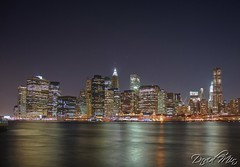
September 11, 2010 Marks Nine-Year Anniversary of World Trade Center Terrorist Attacks
Originally uploaded by GlobeTrotter 2000
A photograph of the NYC skyline without the World Trade Center as viewed from the Brooklyn Heights Promenade.
The Promenade, actually an esplanade, cantilevered over the Brooklyn-Queens Expressway (BQE) is a favorite spot among locals, offering magnificent vistas of the Statue of Liberty, the Manhattan skyline across the East River, as well as views of the Brooklyn Bridge and the Manhattan Bridge. It is a popular tourist destination for the Macy's July 4 fireworks, and for the unobstructed views of the skyline.
Sunday, September 5, 2010
NYC - Brooklyn Bridge Panorama
Walk Across the Brooklyn Bridge. One of the most famous bridges in the nation, the Brooklyn Bridge is located in New York City. It is one of the oldest and largest suspension bridges in the nation and spans more than a mile across the East River. For a time, it was even the longest suspension bridge in the world.
The bridge connects the boroughs of Brooklyn and Manhattan. In 1964, the bridge became a National Historic Landmark, a National Historic Engineering Landmark in 1983, and it is one of the most iconic pieces of New York.
One of the most popular things to do while in New York City is to walk the Brooklyn Bridge. Not everyone knows that this is possible, but close to 5,000 pedestrians and more than 2,500 cyclists cross the bridge in this manner everyday. The walk takes at least half an hour, but most people spend far more time on the bridge, taking pictures and reading the plaques that detail the history of the bridge and the city, as well as point out some interesting sights.
The bridge connects the boroughs of Brooklyn and Manhattan. In 1964, the bridge became a National Historic Landmark, a National Historic Engineering Landmark in 1983, and it is one of the most iconic pieces of New York.
One of the most popular things to do while in New York City is to walk the Brooklyn Bridge. Not everyone knows that this is possible, but close to 5,000 pedestrians and more than 2,500 cyclists cross the bridge in this manner everyday. The walk takes at least half an hour, but most people spend far more time on the bridge, taking pictures and reading the plaques that detail the history of the bridge and the city, as well as point out some interesting sights.
Saturday, September 4, 2010
NYC - Times Square reflections
Times Square is a major commercial intersection in the borough of Manhattan in New York City, at the junction of Broadway and Seventh Avenue and stretching from West 42nd to West 47th Streets. The extended Times Square area, also called the Theatre District, consists of the blocks between Sixth and Eighth Avenues from east to west, and West 40th and West 53rd Streets from south to north, making up the western part of the commercial area of Midtown Manhattan.
Formerly named Longacre Square, Times Square was renamed in April 1904 after the New York Times moved its headquarters to the newly built Times Building, which is now called One Times Square and is the site of the annual ball drop on New Years Eve. Times Square, nicknamed "The Crossroads of the World" and "The Great White Way", has achieved the status of an iconic world landmark and is a symbol of New York City and the United States.
Formerly named Longacre Square, Times Square was renamed in April 1904 after the New York Times moved its headquarters to the newly built Times Building, which is now called One Times Square and is the site of the annual ball drop on New Years Eve. Times Square, nicknamed "The Crossroads of the World" and "The Great White Way", has achieved the status of an iconic world landmark and is a symbol of New York City and the United States.
Thursday, September 2, 2010
NYC Yellow Cab
The taxicabs of New York City, with their distinctive yellow paint, are a widely recognized icon of the city. Taxicabs are operated by private companies and licensed by the New York City Taxi and Limousine Commission. The Commission is a New York City government agency that is best known for its responsibility for the more than 13,237 taxis operating in the city. It also oversees over 40,000 other for-hire vehicles, including "black cars", commuter vans and ambulettes. "Medallion taxis," the familiar yellow cabs, are the only vehicles in the city permitted to pick up passengers in response to a street hail.
Tuesday, August 31, 2010
New York City - Top Of The Rock
Top Of The Rock is an experience in history and scenery that culminates with unparalleled views of New York City from the newly reopened Observation Deck on the 70th floor of 30 Rockefeller Center, in the heart of midtown Manhattan.
There's a certain peace at 70 stories above the city, and Top Of The Rock Observation Deck is conceived with the express purpose of keeping that peace uninterrupted. Panels of fully transparent safety glass - the only thing between visitors and the city - are crystal clear for unobstructed, open-air viewing.
The view itself is unique and astonishing. Unobstructed for 360 degrees from the 70th floor, the breathtaking landscape stretches for miles in every direction. It includes a panorama of Central Park and the northern half of Manhattan that cannot be found anywhere else. New York's other landmarks are visible as well, including the Chrysler Building, Times Square, the Hudson River, the East River, the Brooklyn Bridge, and the Statue of Liberty. It is, quite simply, the most spectacular view in New York City.
There's a certain peace at 70 stories above the city, and Top Of The Rock Observation Deck is conceived with the express purpose of keeping that peace uninterrupted. Panels of fully transparent safety glass - the only thing between visitors and the city - are crystal clear for unobstructed, open-air viewing.
The view itself is unique and astonishing. Unobstructed for 360 degrees from the 70th floor, the breathtaking landscape stretches for miles in every direction. It includes a panorama of Central Park and the northern half of Manhattan that cannot be found anywhere else. New York's other landmarks are visible as well, including the Chrysler Building, Times Square, the Hudson River, the East River, the Brooklyn Bridge, and the Statue of Liberty. It is, quite simply, the most spectacular view in New York City.
Monday, August 30, 2010
New York City - The Glass Cube at 5th Avenue
The store in it self is all underground except for the entrance, a 32-foot glass cube right in front of f the General Motors building opposite the Plaza Hotel and Bergdorf Goodman on 767 Fifth Avenue.
With this incredible entrance Apple has created what could be a new New York Landmark located at a very prominent location on Manhattan.
Beneath the ground level, it’s an amazing world of Apple products, accessories and fanboyzz!! There are 100 Macs and 200 iPods to try before you buy. This Fifth Avenue Apple Store is operational 24-by-7, 365 days a year – one of a kind.
With this incredible entrance Apple has created what could be a new New York Landmark located at a very prominent location on Manhattan.
Beneath the ground level, it’s an amazing world of Apple products, accessories and fanboyzz!! There are 100 Macs and 200 iPods to try before you buy. This Fifth Avenue Apple Store is operational 24-by-7, 365 days a year – one of a kind.
Sunday, August 29, 2010
New York City - Brooklyn Bridge
Walk Across the Brooklyn Bridge. One of the most famous bridges in the nation, the Brooklyn Bridge is located in New York City. It is one of the oldest and largest suspension bridges in the nation and spans more than a mile across the East River. For a time, it was even the longest suspension bridge in the world.
The bridge connects the boroughs of Brooklyn and Manhattan. In 1964, the bridge became a National Historic Landmark, a National Historic Engineering Landmark in 1983, and it is one of the most iconic pieces of New York.
One of the most popular things to do while in New York City is to walk the Brooklyn Bridge. Not everyone knows that this is possible, but close to 5,000 pedestrians and more than 2,500 cyclists cross the bridge in this manner everyday. The walk takes at least half an hour, but most people spend far more time on the bridge, taking pictures and reading the plaques that detail the history of the bridge and the city, as well as point out some interesting sights.
The bridge connects the boroughs of Brooklyn and Manhattan. In 1964, the bridge became a National Historic Landmark, a National Historic Engineering Landmark in 1983, and it is one of the most iconic pieces of New York.
One of the most popular things to do while in New York City is to walk the Brooklyn Bridge. Not everyone knows that this is possible, but close to 5,000 pedestrians and more than 2,500 cyclists cross the bridge in this manner everyday. The walk takes at least half an hour, but most people spend far more time on the bridge, taking pictures and reading the plaques that detail the history of the bridge and the city, as well as point out some interesting sights.
Wednesday, August 18, 2010
Railay Beach - Thailand
I'm gonna take a break at the end of the week for a new destination. See you at my return with new photos.
A place you just need to visit is Railey/Railay beach in Thailand. Railey is one of Thailand's most sought after beach areas. Just south of Ao Nang Beach, around a rocky headland and accessible only by boat, Railay presents a private and extraordinary world.
In just one small peninsula you'll find gorgeous white sand beaches, soaring limestone cliffs, viewpoints, caves and hidden lagoons inside the cliffs, shaped and fed by the changing tides. All within walking distance !
At Railay there are no roads, only footpaths. No buses, no cars, just local "longtail" boats. Although it's actually connected to the mainland, the spectacular Phra Nang peninsular is effectively isolated by limestone headlands and steep jungle valleys from Krabi's main holiday areas. The very picture of tropical paradise, with no roads and no hassle, Railay offers lazy days, adventure forays and chilled-out evenings.
A place you just need to visit is Railey/Railay beach in Thailand. Railey is one of Thailand's most sought after beach areas. Just south of Ao Nang Beach, around a rocky headland and accessible only by boat, Railay presents a private and extraordinary world.
In just one small peninsula you'll find gorgeous white sand beaches, soaring limestone cliffs, viewpoints, caves and hidden lagoons inside the cliffs, shaped and fed by the changing tides. All within walking distance !
At Railay there are no roads, only footpaths. No buses, no cars, just local "longtail" boats. Although it's actually connected to the mainland, the spectacular Phra Nang peninsular is effectively isolated by limestone headlands and steep jungle valleys from Krabi's main holiday areas. The very picture of tropical paradise, with no roads and no hassle, Railay offers lazy days, adventure forays and chilled-out evenings.
Sunday, August 15, 2010
Paris, France - Fountains on the Place de la Concorde
The city of Paris has some of the world's most beautiful fountains. One of the prettiest fountains can be found near the Obelisque at the Place de la Concorde.
The two fountains in the Place de la Concorde have been the most famous of the fountains built during the time of Louis-Philippe, and came to symbolize the fountains in Paris. They were designed by Jacques-Ignace Hittorff, a student of the Neoclassical designer Charles Percier at the Ecole des Beaux-Arts. The German-born Hittorff had served as the official Architect of Festivals and Ceremonies for the deposed King, and had spent two years studying the architecture and fountains of Italy.
Hittorff's two fountains were on the theme of rivers and seas, in part because of their proximity to the Ministry of Navy on the Place de la Concorde, and to the Seine. Their arrangement, on a north-south axis aligned with the obelisk of Luxor, and the Rue Royale, and the form of the fountains themselves, were influenced by the fountains of Rome, particularly Piazza Navona and the Piazza San Pietro, both of which had obelisks aligned with fountains.
The two fountains in the Place de la Concorde have been the most famous of the fountains built during the time of Louis-Philippe, and came to symbolize the fountains in Paris. They were designed by Jacques-Ignace Hittorff, a student of the Neoclassical designer Charles Percier at the Ecole des Beaux-Arts. The German-born Hittorff had served as the official Architect of Festivals and Ceremonies for the deposed King, and had spent two years studying the architecture and fountains of Italy.
Hittorff's two fountains were on the theme of rivers and seas, in part because of their proximity to the Ministry of Navy on the Place de la Concorde, and to the Seine. Their arrangement, on a north-south axis aligned with the obelisk of Luxor, and the Rue Royale, and the form of the fountains themselves, were influenced by the fountains of Rome, particularly Piazza Navona and the Piazza San Pietro, both of which had obelisks aligned with fountains.
Saturday, August 14, 2010
Siem Reap, Cambodia - Angkor Wat
If you've read anything at all about Angkor Wat, you'll probably know at least three things: Angkor is one of the most beautiful and suggestive place on the planet, the Angkor Wat Temples area is much bigger than the Angkor Temple alone, and last, nothing is homogeneous, being the temples built in different times, during a four centuries process.
Many people, when they hear the name Angkor in a conversation, they ask: "Angkor What?". Angkor Wat is one of the most beautiful and fascinating places on the planet. Made by the Khmer kings in a process that lasts almost 4 centuries, this magnificent area has been abandoned and hidden by the forest. Re-discovered by a french man about 150 years ago, Angkor Wat is ready to become one of the most visited archaeological and artistic site on the planet.
Many people, when they hear the name Angkor in a conversation, they ask: "Angkor What?". Angkor Wat is one of the most beautiful and fascinating places on the planet. Made by the Khmer kings in a process that lasts almost 4 centuries, this magnificent area has been abandoned and hidden by the forest. Re-discovered by a french man about 150 years ago, Angkor Wat is ready to become one of the most visited archaeological and artistic site on the planet.
Thursday, August 12, 2010
Niagara Falls, Canada - American Falls
The Niagara Falls are voluminous waterfalls on the Niagara River, straddling the international border between the Canadian province of Ontario and the U.S. state of New York. Niagara Falls is composed of two major sections separated by Goat Island: Horseshoe Falls, the majority of which lies on the Canadian side of the border, and American Falls on the American side.
The Niagara Falls are renowned both for their beauty and as a valuable source of hydroelectric power.
This shot was taken from the Canadian side at night.
The Niagara Falls are renowned both for their beauty and as a valuable source of hydroelectric power.
This shot was taken from the Canadian side at night.
Wednesday, August 11, 2010
Iquitos, Peru - Amazon River
Iquitos is the largest city in the Peruvian rainforest, with a population of 370,962. It is generally considered the most populous city in the world that cannot be reached by road.
Located on the Amazon River, it is a mere 106 m above sea level even though it is more than 3,000 km from the mouth of the Amazon at Belém in Brazil, on the Atlantic Ocean. Iquitos has long been a major port in the Amazon Basin. It is surrounded by three rivers: the Nanay, the Itaya, and the Amazon.
The city can be reached only by airplane or boat, with the exception of a road to Nauta, a small town roughly 100 km (62 mi) south.
The climate is hot and humid, with an average relative humidity of 85%. The wet season lasts from around November to May, with the river reaching its highest point in May. The river is at its lowest in October.
A boat tour of Belén is a common tourist attraction. Belén is an area east of Iquitos that can be accessed by foot and moto-carro both in the dry and wet seasons. However, many of the homes in this area are tethered to large poles and float upon the rising waters every year, and some homes float year-round. Where the waters begin there are often a few men with their boats who transport locals and tourists for a small fee.
Located on the Amazon River, it is a mere 106 m above sea level even though it is more than 3,000 km from the mouth of the Amazon at Belém in Brazil, on the Atlantic Ocean. Iquitos has long been a major port in the Amazon Basin. It is surrounded by three rivers: the Nanay, the Itaya, and the Amazon.
The city can be reached only by airplane or boat, with the exception of a road to Nauta, a small town roughly 100 km (62 mi) south.
The climate is hot and humid, with an average relative humidity of 85%. The wet season lasts from around November to May, with the river reaching its highest point in May. The river is at its lowest in October.
A boat tour of Belén is a common tourist attraction. Belén is an area east of Iquitos that can be accessed by foot and moto-carro both in the dry and wet seasons. However, many of the homes in this area are tethered to large poles and float upon the rising waters every year, and some homes float year-round. Where the waters begin there are often a few men with their boats who transport locals and tourists for a small fee.
Monday, August 9, 2010
Paris, France - The Eiffel Tower
The Eiffel Tower is an 1889 iron lattice tower located on the Champ de Mars in Paris that has become both a global icon of France and one of the most recognizable structures in the world. The Eiffel Tower, which is the tallest building in Paris, is the single most visited paid monument in the world; millions of people ascend it every year. Named after its designer, engineer Gustave Eiffel, the tower was built as the entrance arch for the 1889 World's Fair.
The tower stands 324 m tall, about the same height as an 81-storey building. It was the tallest man-made structure in the world from its completion until the Chrysler Building in New York City was built in 1930.The tower has three levels for visitors. Tickets can be purchased to ascend by stairs or lift to the first and second levels. The walk to the first level is over 300 steps, as is the walk from the first to the second level. The third and highest level is accessible only by lift. Both the first and second levels feature restaurants.
The tower has become the most prominent symbol of both Paris and France, often in the establishing shot of films set in the city.
The tower stands 324 m tall, about the same height as an 81-storey building. It was the tallest man-made structure in the world from its completion until the Chrysler Building in New York City was built in 1930.The tower has three levels for visitors. Tickets can be purchased to ascend by stairs or lift to the first and second levels. The walk to the first level is over 300 steps, as is the walk from the first to the second level. The third and highest level is accessible only by lift. Both the first and second levels feature restaurants.
The tower has become the most prominent symbol of both Paris and France, often in the establishing shot of films set in the city.
Sunday, August 8, 2010
Paris, France - Fountains on the Place de la Concorde
The city of Paris has some of the world's most beautiful fountains. One of the prettiest fountains can be found near the Obelisque at the Place de la Concorde.
The two fountains in the Place de la Concorde have been the most famous of the fountains built during the time of Louis-Philippe, and came to symbolize the fountains in Paris. They were designed by Jacques-Ignace Hittorff, a student of the Neoclassical designer Charles Percier at the Ecole des Beaux-Arts. The German-born Hittorff had served as the official Architect of Festivals and Ceremonies for the deposed King, and had spent two years studying the architecture and fountains of Italy.
Hittorff's two fountains were on the theme of rivers and seas, in part because of their proximity to the Ministry of Navy on the Place de la Concorde, and to the Seine. Their arrangement, on a north-south axis aligned with the obelisk of Luxor, and the Rue Royale, and the form of the fountains themselves, were influenced by the fountains of Rome, particularly Piazza Navona and the Piazza San Pietro, both of which had obelisks aligned with fountains.
The two fountains in the Place de la Concorde have been the most famous of the fountains built during the time of Louis-Philippe, and came to symbolize the fountains in Paris. They were designed by Jacques-Ignace Hittorff, a student of the Neoclassical designer Charles Percier at the Ecole des Beaux-Arts. The German-born Hittorff had served as the official Architect of Festivals and Ceremonies for the deposed King, and had spent two years studying the architecture and fountains of Italy.
Hittorff's two fountains were on the theme of rivers and seas, in part because of their proximity to the Ministry of Navy on the Place de la Concorde, and to the Seine. Their arrangement, on a north-south axis aligned with the obelisk of Luxor, and the Rue Royale, and the form of the fountains themselves, were influenced by the fountains of Rome, particularly Piazza Navona and the Piazza San Pietro, both of which had obelisks aligned with fountains.
Friday, August 6, 2010
Paris, France - Fountains on the Place de la Concorde
The city of Paris has some of the world's most beautiful fountains. One of the prettiest fountains can be found near the Obelisque at the Place de la Concorde.
The two fountains in the Place de la Concorde have been the most famous of the fountains built during the time of Louis-Philippe, and came to symbolize the fountains in Paris. They were designed by Jacques-Ignace Hittorff, a student of the Neoclassical designer Charles Percier at the Ecole des Beaux-Arts. The German-born Hittorff had served as the official Architect of Festivals and Ceremonies for the deposed King, and had spent two years studying the architecture and fountains of Italy.
Hittorff's two fountains were on the theme of rivers and seas, in part because of their proximity to the Ministry of Navy on the Place de la Concorde, and to the Seine. Their arrangement, on a north-south axis aligned with the obelisk of Luxor, and the Rue Royale, and the form of the fountains themselves, were influenced by the fountains of Rome, particularly Piazza Navona and the Piazza San Pietro, both of which had obelisks aligned with fountains.
The two fountains in the Place de la Concorde have been the most famous of the fountains built during the time of Louis-Philippe, and came to symbolize the fountains in Paris. They were designed by Jacques-Ignace Hittorff, a student of the Neoclassical designer Charles Percier at the Ecole des Beaux-Arts. The German-born Hittorff had served as the official Architect of Festivals and Ceremonies for the deposed King, and had spent two years studying the architecture and fountains of Italy.
Hittorff's two fountains were on the theme of rivers and seas, in part because of their proximity to the Ministry of Navy on the Place de la Concorde, and to the Seine. Their arrangement, on a north-south axis aligned with the obelisk of Luxor, and the Rue Royale, and the form of the fountains themselves, were influenced by the fountains of Rome, particularly Piazza Navona and the Piazza San Pietro, both of which had obelisks aligned with fountains.
Wednesday, August 4, 2010
Vancouver Island, Canada - Cape Scott
Cape Scott Provincial Park is a 21,849 hectare, rugged coastal wilderness at the northwest tip of Vancouver Island. The park is characterized by 64 kilometers of spectacular ocean frontage, including about 23 kilometers of beaches, running from Nissen Bight in the north to San Josef Bay in the south. Rocky promontories and headlands intersperse wide sandy beaches.
The heavy rainfalls and violent windstorms of the Cape Scott area have shaped its history. Annual precipitation, almost totally in the form of rain, is between 375 and 500 centimeters. Even in summer, prolonged sunny periods are a rarity. High winds, rain and generally stormy conditions can be expected at any time of the year.
To access to this piece of paradise, it is a little bit complicated ! After a couple hours of driving, at the end of the road, you can park your car and hike along a beautiful, yet easy, wooded trail until reaching the Pacific Ocean, beyond a wide stretch of soft sandy beach. But the best part is the tiny cove, with rocky outcroppings right on the beach. There are even caves and miniature bonsai trees! More amazing than it might sound, this sight made the long trip more than worthwhile!
The heavy rainfalls and violent windstorms of the Cape Scott area have shaped its history. Annual precipitation, almost totally in the form of rain, is between 375 and 500 centimeters. Even in summer, prolonged sunny periods are a rarity. High winds, rain and generally stormy conditions can be expected at any time of the year.
To access to this piece of paradise, it is a little bit complicated ! After a couple hours of driving, at the end of the road, you can park your car and hike along a beautiful, yet easy, wooded trail until reaching the Pacific Ocean, beyond a wide stretch of soft sandy beach. But the best part is the tiny cove, with rocky outcroppings right on the beach. There are even caves and miniature bonsai trees! More amazing than it might sound, this sight made the long trip more than worthwhile!
Tuesday, August 3, 2010
Paris, Pont Alexandre III
Pont Alexandre III is an arch bridge that spans the Seine, connecting the Champs-Élysées quarter and the Invalides and Eiffel Tower quarter, widely regarded as the most ornate, extravagant bridge in Paris.
The bridge, with its exuberant Art Nouveau lamps, cherubs, nymphs and winged horses at either end, was built between 1896 and 1900. It is named after Tsar Alexander III, who had concluded the Franco-Russian Alliance in 1892. His son Nicholas II laid the foundation stone in October 1896. The style of the bridge reflects that of the Grand Palais, to which it leads on the right bank.
The construction of the bridge is a marvel of 19th century engineering, consisting of a six-metre high single span steel arch. The design, by the architects Joseph Cassien-Bernard and Gaston Cousin, was subject to strict controls that prevented the bridge from obscuring the view of the Champs-Élysées or the Invalides.
The bridge, with its exuberant Art Nouveau lamps, cherubs, nymphs and winged horses at either end, was built between 1896 and 1900. It is named after Tsar Alexander III, who had concluded the Franco-Russian Alliance in 1892. His son Nicholas II laid the foundation stone in October 1896. The style of the bridge reflects that of the Grand Palais, to which it leads on the right bank.
The construction of the bridge is a marvel of 19th century engineering, consisting of a six-metre high single span steel arch. The design, by the architects Joseph Cassien-Bernard and Gaston Cousin, was subject to strict controls that prevented the bridge from obscuring the view of the Champs-Élysées or the Invalides.
Monday, August 2, 2010
Cruz del Condor Lookout, Peru
Colca Canyon is a canyon of the Colca River in southern Peru. It is located about 160 km northwest of Arequipa. It is more than twice as deep as the Grand Canyon in the United States at 4,160 m. However, the canyon's walls are not as vertical as those of the Grand Canyon.
The canyon is home to the Andean Condor, a species that has seen worldwide effort to preserve it. The condors can be seen at fairly close range as they fly through the canyon walls and are an increasingly popular attraction. 'Cruz del Condor' is a popular tourist stop to view the condors, the pass where condors soar gracefully on the rising thermals occurring as the air warms. The condors are best seen in the early morning and late afternoon when they are hunting. At this point the canyon floor is 1,200 m below the rim of the canyon.
The canyon is home to the Andean Condor, a species that has seen worldwide effort to preserve it. The condors can be seen at fairly close range as they fly through the canyon walls and are an increasingly popular attraction. 'Cruz del Condor' is a popular tourist stop to view the condors, the pass where condors soar gracefully on the rising thermals occurring as the air warms. The condors are best seen in the early morning and late afternoon when they are hunting. At this point the canyon floor is 1,200 m below the rim of the canyon.
Sunday, August 1, 2010
Paris, France - Notre Dame de Paris
The Gothic loftiness of Notre-Dame dominates the Seine and the Ile-de-la-Cité as well as the history of Paris.
Notre-Dame de Paris is a church, a place of Roman Catholic worship, where Christians come together to pray. It opens its doors to people to participate in services or to freely visit the cathedral all year long.
Notre Dame de Paris was among the first buildings in the world to use the flying buttress (arched exterior supports). The building was not originally designed to include the flying buttresses around the choir and nave. After the construction began and the thinner walls (popularized in the Gothic style) grew ever higher, stress fractures began to occur as the walls pushed outward. In response, the cathedral's architects built supports around the outside walls, and later additions continued the pattern.
For a look at the upper parts of the church, the river, and much of Paris, climb the 387 steps to the top of one of the towers.
Notre-Dame de Paris is a church, a place of Roman Catholic worship, where Christians come together to pray. It opens its doors to people to participate in services or to freely visit the cathedral all year long.
Notre Dame de Paris was among the first buildings in the world to use the flying buttress (arched exterior supports). The building was not originally designed to include the flying buttresses around the choir and nave. After the construction began and the thinner walls (popularized in the Gothic style) grew ever higher, stress fractures began to occur as the walls pushed outward. In response, the cathedral's architects built supports around the outside walls, and later additions continued the pattern.
For a look at the upper parts of the church, the river, and much of Paris, climb the 387 steps to the top of one of the towers.
Saturday, July 31, 2010
Cuzco, Peru - Plaza de Armas
Plaza de Armas is the center of the Historic section in Cuzco.
Plaza de Armas is a beautifully landscaped plaza that includes a mixture of patterned trees and benches. The abundant shade, benches, sitting walls and steps make the plaza a popular lunchtime destination. The steps at the entry of the two Spanish Churches are also great for sitting, and are often used for elevated speaker platforms. Historically, the Plaza has served as the city’s primary meeting place. There are numerous cafes, restaurants, and stores spilling out into the Plaza. Many of the restaurants have outdoor tables, and there is constant entertainment throughout the day and night.
People often cross through the Plaza as a short cut away from traffic or to avoid the curvy roads of Cuzco. The Plaza is most accessible by foot, but people often arrive by car. The most common meeting location for tourist groups is at the entrance stairs of La Cathedral in the Plaza. The Plaza is located at the center of the City and is accessible from all directions, making it a great meeting location.
At first you’ll observe the high velocity of people circulating throughout the Plaza. This is comforting for persons new to the area. Vehicles tend avoid the street adjacent to the plaza and also yield to pedestrians. The Plaza is well lit and offers various nooks and crannies to socialize in or to just be alone in.
Plaza de Armas is a beautifully landscaped plaza that includes a mixture of patterned trees and benches. The abundant shade, benches, sitting walls and steps make the plaza a popular lunchtime destination. The steps at the entry of the two Spanish Churches are also great for sitting, and are often used for elevated speaker platforms. Historically, the Plaza has served as the city’s primary meeting place. There are numerous cafes, restaurants, and stores spilling out into the Plaza. Many of the restaurants have outdoor tables, and there is constant entertainment throughout the day and night.
People often cross through the Plaza as a short cut away from traffic or to avoid the curvy roads of Cuzco. The Plaza is most accessible by foot, but people often arrive by car. The most common meeting location for tourist groups is at the entrance stairs of La Cathedral in the Plaza. The Plaza is located at the center of the City and is accessible from all directions, making it a great meeting location.
At first you’ll observe the high velocity of people circulating throughout the Plaza. This is comforting for persons new to the area. Vehicles tend avoid the street adjacent to the plaza and also yield to pedestrians. The Plaza is well lit and offers various nooks and crannies to socialize in or to just be alone in.
Thursday, July 29, 2010
Bangkok, Thailand - Wat Phra Keaw
Wat Phra Kaew, the Temple of the Emerald Buddha, and the adjoining Grand Palace together form perhaps the greatest spectacle for the visitor to Bangkok. Despite the fact that the whole compound is so full of tourists you spend half the time trying to avoid getting in people's photos, it's still a pretty amazing place to visit.
It consists of over 100 brightly colored buildings, golden spires and glittering mosaics, and dates back to 1782, when Bangkok was founded. When you enter the compound, you first of all see Wat Phra Kaew and the nearby attractions, and then move on to the Grand Palace afterwards.
Wat Phra Kaew itself, generally known to the Thais as Wat Phra Si Rattana Satsadaram, is perhaps the main attraction. This is Thailand's most important and sacred temple, so you're expected to act with due respect inside it. It houses the tiny (between 60 and 75 cm) Emerald Buddha, which is located high above the heads of the worshippers and tourists. Not much is known for certain about the statue, except that it isn't actually made of emerald but rather of green jade or jasper. Getting a good look at it is difficult as photography is forbidden inside the temple, and it's perched so high up inside it's glass box that it's difficult to really see.
It consists of over 100 brightly colored buildings, golden spires and glittering mosaics, and dates back to 1782, when Bangkok was founded. When you enter the compound, you first of all see Wat Phra Kaew and the nearby attractions, and then move on to the Grand Palace afterwards.
Wat Phra Kaew itself, generally known to the Thais as Wat Phra Si Rattana Satsadaram, is perhaps the main attraction. This is Thailand's most important and sacred temple, so you're expected to act with due respect inside it. It houses the tiny (between 60 and 75 cm) Emerald Buddha, which is located high above the heads of the worshippers and tourists. Not much is known for certain about the statue, except that it isn't actually made of emerald but rather of green jade or jasper. Getting a good look at it is difficult as photography is forbidden inside the temple, and it's perched so high up inside it's glass box that it's difficult to really see.
Wednesday, July 28, 2010
Cusco, Peru - Iglesia La Compañía de Jesús (Jesuit Church)
Near Cusco Cathedral is the Church of the Society of Jesus (Iglesia La Compañía de Jesús) which rivals the cathedral in grandeur and prominence on the main square.
La Compañía de Jesús is said to be one of the best examples of colonial Baroque architecture in the Americas. Inside, it's rather gloomy, but the gilded altar is stunning, especially when illuminated. The golden altarpiece, decorated with wreathed columns, features an old image of the Virgin and a panel of the Transfiguration attributed to the Flemish Jesuit Diego de la Puente.
La Compañía possesses several other important works of art, including a picture of Saint Ignatius de Loyola by the local painter Marcos Zapata, and a Crucifixion by Cristo de Burgos near the main altar.
La Compañía de Jesús is said to be one of the best examples of colonial Baroque architecture in the Americas. Inside, it's rather gloomy, but the gilded altar is stunning, especially when illuminated. The golden altarpiece, decorated with wreathed columns, features an old image of the Virgin and a panel of the Transfiguration attributed to the Flemish Jesuit Diego de la Puente.
La Compañía possesses several other important works of art, including a picture of Saint Ignatius de Loyola by the local painter Marcos Zapata, and a Crucifixion by Cristo de Burgos near the main altar.
Sunday, July 25, 2010
Bank of China, Central Hong Kong
The Bank of China Tower is one of the most recognized skyscrapers in Central, Hong Kong. It houses the headquarters for the Bank of China (Hong Kong) Limited.
If Hong Kong is a city of jade during the day, it becomes a luminous pearl with a sea of lights twinkling in the streets after dark. Where is the best place to enjoy the multi-colorful night scene that encompasses Hong Kong and Victoria Harbor? Victoria Peak is a good location to view its night scene. Being 554 meters above sea level, Victoria Peak is the highest point within Hong Kong and occupies the western part of the island.
Viewing Hong Kong at night is a must! The panoramic vista is one of the most beautiful night scenes in the world so a visit to the Lion Pavilion on the peak is a must. Standing upon the pavilion and overlooking the Victoria Harbor and the Kowloon Peninsula, a spectacular night view will unfold in front of your eyes. The Victoria Harbor is one of the world's busiest harbors and has a constant ebb and flow of shipping all year round. With row upon row of skyscrapers stand prominently on the Central District which is Hong Kong's financial and economic hub. The most spectacular are the Bank of China Tower and the Central Plaza. The Bank of China Tower, with 72 stories soars skyward and is designed by an American-born Chinese architect Ieoh Ming Pei; with the bamboo-shaped outlook of the tower symbolizing that the Bank of China aspires to get better and better.
If Hong Kong is a city of jade during the day, it becomes a luminous pearl with a sea of lights twinkling in the streets after dark. Where is the best place to enjoy the multi-colorful night scene that encompasses Hong Kong and Victoria Harbor? Victoria Peak is a good location to view its night scene. Being 554 meters above sea level, Victoria Peak is the highest point within Hong Kong and occupies the western part of the island.
Viewing Hong Kong at night is a must! The panoramic vista is one of the most beautiful night scenes in the world so a visit to the Lion Pavilion on the peak is a must. Standing upon the pavilion and overlooking the Victoria Harbor and the Kowloon Peninsula, a spectacular night view will unfold in front of your eyes. The Victoria Harbor is one of the world's busiest harbors and has a constant ebb and flow of shipping all year round. With row upon row of skyscrapers stand prominently on the Central District which is Hong Kong's financial and economic hub. The most spectacular are the Bank of China Tower and the Central Plaza. The Bank of China Tower, with 72 stories soars skyward and is designed by an American-born Chinese architect Ieoh Ming Pei; with the bamboo-shaped outlook of the tower symbolizing that the Bank of China aspires to get better and better.
Friday, July 23, 2010
Puno, Peru - Viewpoint
Puno city is the capital of the department of Puno. It was founded with the name of "Villa Rica de San Carlos de Puno" in 1668, by the Viceroy Count of Lemos, to end with the problems of possession of the silver mines of Laicacota of the brothers Gaspar and José Salcedo.
Lake port beside the Titicaca, the highest navigable lake in the world. It have landscapes of indescribable beauty, it has been the origin and cradle of big pre-Hispanic civilizations as Tiahuanaco, Collas and Aymaras, and of the mythical legend of Manco Capac and Mama Ocllo who emerged of its waters and went to Cuzco to found the capital of the Inca empire.
Lving Culture: The Uros, famous and ancestral town that live in floating artificial islands, or the indigenous communities of Taquile and Amantani that maintain their customs and rites without changes in the course of the time, amid unique landscapes.
Lake port beside the Titicaca, the highest navigable lake in the world. It have landscapes of indescribable beauty, it has been the origin and cradle of big pre-Hispanic civilizations as Tiahuanaco, Collas and Aymaras, and of the mythical legend of Manco Capac and Mama Ocllo who emerged of its waters and went to Cuzco to found the capital of the Inca empire.
Lving Culture: The Uros, famous and ancestral town that live in floating artificial islands, or the indigenous communities of Taquile and Amantani that maintain their customs and rites without changes in the course of the time, amid unique landscapes.
Thursday, July 22, 2010
La Paz, Bolivia - Apocalyptic day @ The Death Road aka "The World's Most Dangerous Road"

La Paz, Bolivia - Apocalyptic day @ The Death Road aka "The World's Most Dangerous Road"
Originally uploaded by GlobeTrotter 2000
The Death Road is a 61-kilometre road leading from La Paz to Coroico, 56 kilometres northeast of La Paz in the Yungas region of Bolivia. It is legendary for its extreme danger and in 1995 the Inter-American Development Bank christened it as the "world's most dangerous road".
One estimate is that 200 to 300 travellers were killed yearly along the road. The road includes crosses marking many of the spots where vehicles have fallen. Because of the extreme dropoffs of at least 600 metres, single-lane width – most of the road no wider than 3.2 metres and lack of guard rails, the road is extremely dangerous. Further still, rain, fog and dust can make visibility precarious. In many places the road surface is muddy, and can loosen rocks from the road.
The danger of the road ironically made it a popular tourist destination starting in the 1990s, drawing some 25,000 thrillseekers. Mountain biking enthusiasts in particular have made it a favourite destination for downhill biking since there is a 64-kilometre stretch of continuous downhill riding with only one short uphill section. There are now many tour operators catering to this activity, providing information, guides, transport and equipment. Nevertheless, the Yungas Road remains dangerous. At least 18 of these cyclists died on the ride since 1998.
Monday, July 19, 2010
La Paz, Bolivia
Nuestra Señora de La Paz is the administrative capital of Bolivia. It is located at an elevation of 3,660 meters above sea level, making it the world's highest capital city. The city sits in a "bowl" surrounded by the high mountains of the altiplano. As it grows, La Paz climbs the hills, resulting in varying elevations from 3,000 meters to 4,100 meters. Overlooking the city is towering triple-peaked Illimani, which is always snow-covered and can be seen from several spots of the city, including from the neighbor city, El Alto.
La Paz is an important cultural center of Bolivia. The city hosts several cathedrals belonging to the colonial times, such as the San Francisco Cathedral and the Metropolitan Cathedral, this last one located on Murillo Square, which is also home of the political and administrative power of the country. Hundreds of different museums can be found across the city, the most notable ones on Jaén Street, which street design has been preserved from the Spanish days and is home of 10 different museums.
La Paz is an important cultural center of Bolivia. The city hosts several cathedrals belonging to the colonial times, such as the San Francisco Cathedral and the Metropolitan Cathedral, this last one located on Murillo Square, which is also home of the political and administrative power of the country. Hundreds of different museums can be found across the city, the most notable ones on Jaén Street, which street design has been preserved from the Spanish days and is home of 10 different museums.
Sunday, July 18, 2010
Paris, France - Notre Dame de Paris
The Gothic loftiness of Notre-Dame dominates the Seine and the Ile-de-la-Cité as well as the history of Paris.
Notre-Dame de Paris is a church, a place of Roman Catholic worship, where Christians come together to pray. It opens its doors to people to participate in services or to freely visit the cathedral all year long.
Notre Dame de Paris was among the first buildings in the world to use the flying buttress (arched exterior supports). The building was not originally designed to include the flying buttresses around the choir and nave. After the construction began and the thinner walls (popularized in the Gothic style) grew ever higher, stress fractures began to occur as the walls pushed outward. In response, the cathedral's architects built supports around the outside walls, and later additions continued the pattern.
For a look at the upper parts of the church, the river, and much of Paris, climb the 387 steps to the top of one of the towers.
Notre-Dame de Paris is a church, a place of Roman Catholic worship, where Christians come together to pray. It opens its doors to people to participate in services or to freely visit the cathedral all year long.
Notre Dame de Paris was among the first buildings in the world to use the flying buttress (arched exterior supports). The building was not originally designed to include the flying buttresses around the choir and nave. After the construction began and the thinner walls (popularized in the Gothic style) grew ever higher, stress fractures began to occur as the walls pushed outward. In response, the cathedral's architects built supports around the outside walls, and later additions continued the pattern.
For a look at the upper parts of the church, the river, and much of Paris, climb the 387 steps to the top of one of the towers.
Saturday, July 17, 2010
Cuzco, Peru - Plaza de Armas
Plaza de Armas is the center of the Historic section in Cuzco.
Plaza de Armas is a beautifully landscaped plaza that includes a mixture of patterned trees and benches. The abundant shade, benches, sitting walls and steps make the plaza a popular lunchtime destination. The steps at the entry of the two Spanish Churches are also great for sitting, and are often used for elevated speaker platforms. Historically, the Plaza has served as the city’s primary meeting place. There are numerous cafes, restaurants, and stores spilling out into the Plaza. Many of the restaurants have outdoor tables, and there is constant entertainment throughout the day and night.
People often cross through the Plaza as a short cut away from traffic or to avoid the curvy roads of Cuzco. The Plaza is most accessible by foot, but people often arrive by car. The most common meeting location for tourist groups is at the entrance stairs of La Cathedral in the Plaza. The Plaza is located at the center of the City and is accessible from all directions, making it a great meeting location.
At first you’ll observe the high velocity of people circulating throughout the Plaza. This is comforting for persons new to the area. Vehicles tend avoid the street adjacent to the plaza and also yield to pedestrians. The Plaza is well lit and offers various nooks and crannies to socialize in or to just be alone in.
Plaza de Armas is a beautifully landscaped plaza that includes a mixture of patterned trees and benches. The abundant shade, benches, sitting walls and steps make the plaza a popular lunchtime destination. The steps at the entry of the two Spanish Churches are also great for sitting, and are often used for elevated speaker platforms. Historically, the Plaza has served as the city’s primary meeting place. There are numerous cafes, restaurants, and stores spilling out into the Plaza. Many of the restaurants have outdoor tables, and there is constant entertainment throughout the day and night.
People often cross through the Plaza as a short cut away from traffic or to avoid the curvy roads of Cuzco. The Plaza is most accessible by foot, but people often arrive by car. The most common meeting location for tourist groups is at the entrance stairs of La Cathedral in the Plaza. The Plaza is located at the center of the City and is accessible from all directions, making it a great meeting location.
At first you’ll observe the high velocity of people circulating throughout the Plaza. This is comforting for persons new to the area. Vehicles tend avoid the street adjacent to the plaza and also yield to pedestrians. The Plaza is well lit and offers various nooks and crannies to socialize in or to just be alone in.
Subscribe to:
Posts (Atom)
